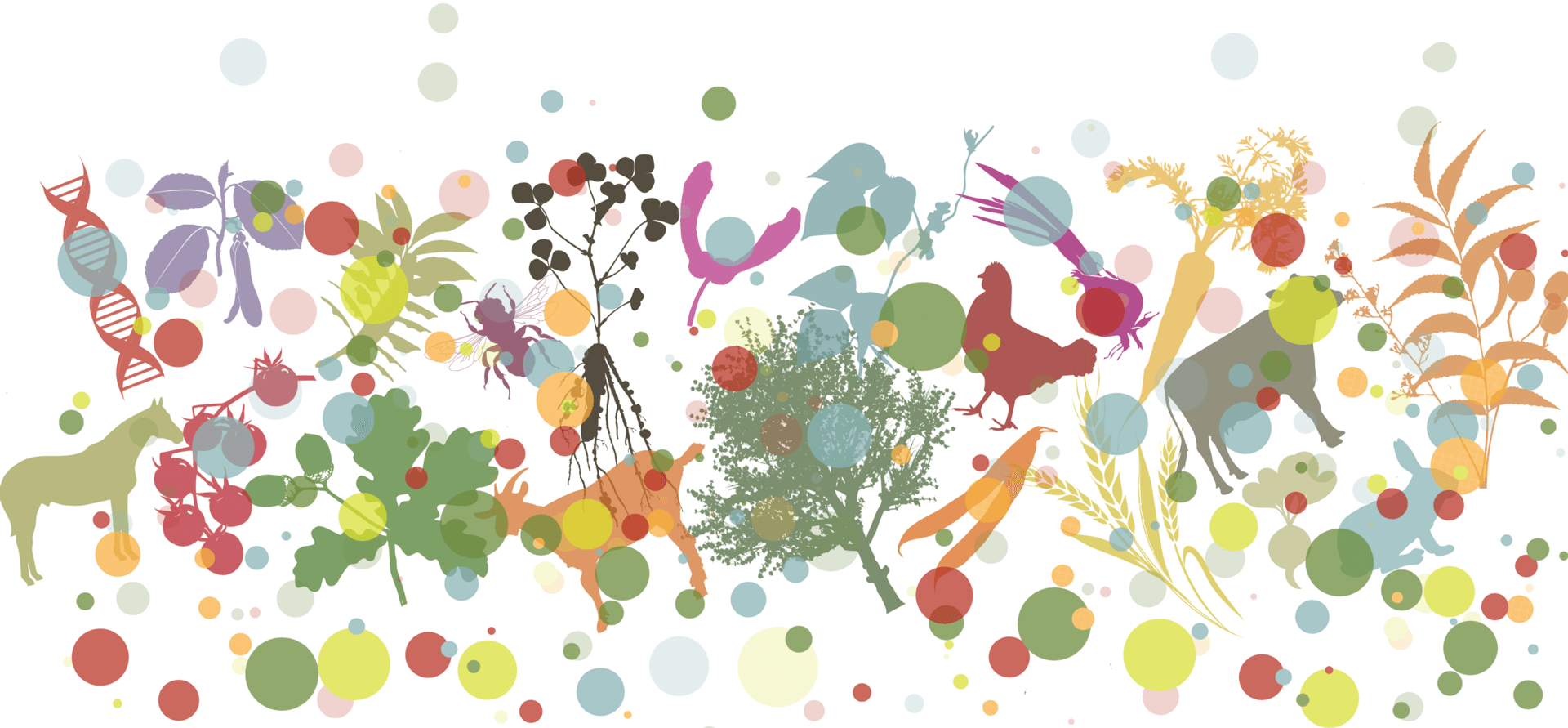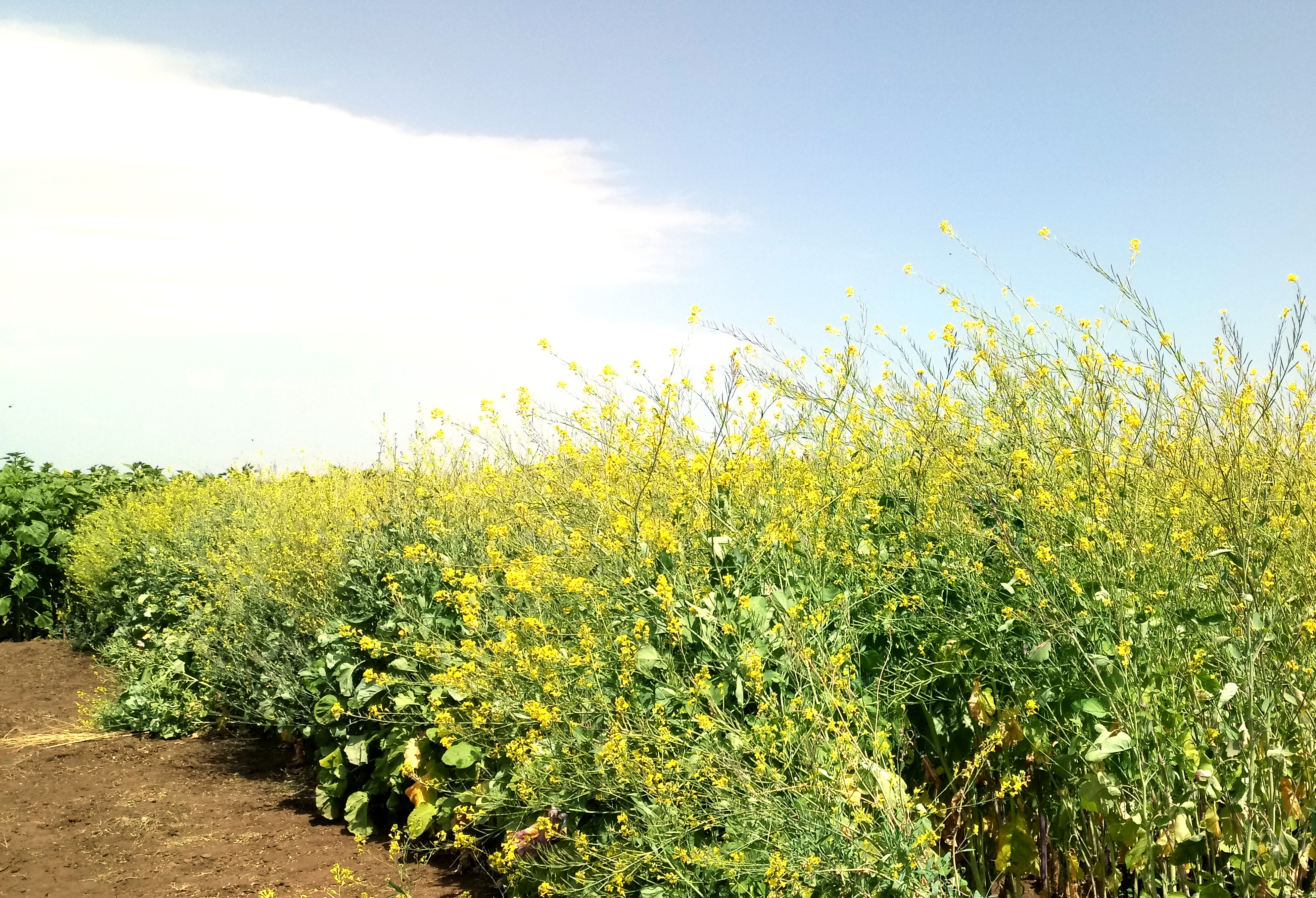Morphological and biochemical characterization of Ethiopian mustard (Brassica carinata A. Braun) germplasm grown in Central Ethiopia Ethiopian Mustard Germplasm Characterization
Main Article Content
Abstract
Ethiopian mustard (Brassica carinata A. Braun) shows potential for diverse applications, including as leafy greens, green manure and oilseed feedstock for biofuels. This study evaluated the seed and oil production potential and phenotypic diversity of 49 B. carinata accessions through trials conducted in 2018 at the Holeta and Asela Research Centers in Ethiopia, using a lattice design. Data were collected on phenological, morphological, agronomic and seed quality traits. The analysis revealed significant variability across most traits, except for silique width and oil and protein content at Asela, and main raceme length and total glucosinolate content at Holeta. Combined analysis showed significant genotype-by-location interactions for flowering date, seeds per silique and seed yield per hectare, indicating a strong environmental influence on these traits. Phenotypic and genotypic correlation analyses identified strong positive correlations between leaf traits and phenology, seed yield and seed quality, while oil content was negatively associated with protein and glucosinolate content. Principal component analysis identified five components at Asela and six components at Holeta with eigenvalues greater than one, explaining over 77% of the total variation at both locations. Key traits such as plant height, seed yield and oil content contributed significantly to these principal components. Cluster analysis grouped the accessions into three clusters based on distinct trait combinations. Accessions 17545, 21373, 24203 and 24495 consistently performed well across multiple traits across sites, making them strong candidates for breeding programmes focused on improving seed yield and quality in B. carinata.
Article Details

This work is licensed under a Creative Commons Attribution 4.0 International License.
Authors retain copyright of the articles published in Genetic Resources and grant the journal right of first publication with open access. All articles published in Genetic Resource are licensed under Creative Commons Attribution 4.0 International License (CC BY 4.0) that allows others to download, share and adapt the work for commercial and non-commercial purposes as long as proper attribution to the original article is given. Genetic Resources permits and encourages authors to post items submitted to the journal (including the publisher's final layout) on personal websites or institutional repositories after acceptance and/or publication, while providing bibliographic details that credit their publication in Genetic Resources.
Abraha, R H et al. (2024). “Characterization and evaluation of the morphological attributes of Ethiopian mustard (Brassica carinata A. Braun) landraces”. Euphytica 220(3), pp. 1–15. DOI: https://doi.org/10.1007/s10681-023-03284-0. DOI: https://doi.org/10.1007/s10681-023-03284-0
Abu, M, B Mengistu, and T Molla (2022). “Genotype by Environment Interaction and Stability Analysis in Ethiopian Mustard ( Brassica Carinata A Braun ) Using AMMI Biplot and Stability Parameters”. American Journal of Life Sciences 10(3), pp. 39–44. DOI: https://doi.org/10.11648/j.ajls.20221003.12. DOI: https://doi.org/10.11648/j.ajls.20221003.12
Adeniji, O T and A A Aloyce (2012). “Floral and Seed Variability Patterns among Ethiopian Mustard (B. carinata A. Braun) of East Africa”. Tropicultura 30(3), pp. 133–140.
Alemaw, G and F Gurmu (2023). “Towards edible oil self-sufficiency in Ethiopia : Lessons and prospects”. Cogent Food & Agriculture 9(1). DOI: https://doi.org/10.1080/23311932.2023.2198742. DOI: https://doi.org/10.1080/23311932.2023.2198742
Ambaw, Y D, A G Abitea, and T M Olango (2024). “Genetic variation in Ethiopian mustard ( Brassica carinata A. Braun ) germplasm based on seed oil content and fatty acid composition”. Genetic Resources and Crop Evolution 72. DOI: https://doi.org/10.1007/s10722-024-02155-4. DOI: https://doi.org/10.1007/s10722-024-02155-4
Ambaw, Y D, A G Abitea, T M Olango, and B M Aboye (2024). “Agromorphological and Physiological Trait Diversity in Ethiopian Mustard (Brassica carinata A . Braun) ”. Germplasm. Advances in Agriculture 1. DOI: https://doi.org/10.1155/aia/2398294
Amsalu, F (2020a). “Genetic Variability, Correlation and Path Coefficient Analysis of Ethiopian Mustard (Brasica Carinata A. Braun) Genotypes”. International Journal of Research Studies in Agricultural Sciences 6(3), pp. 17–25.
Amsalu, F (2020b). “Genetic Variability Correlation and Path Coefficient Analysis of Ethiopian Mustard Genotypes”. International Journal of Research Studies in Agricultural Science 6(3), pp. 17–25. DOI: https://doi.org/10.3329/sja.v18i1.48378. DOI: https://doi.org/10.20431/2454-6224.0603003
Amsalu, F (2020c). “Leaf Traits Variability of Ethiopian Mustard (Brasica Carinata A. Braun) Landraces in their Different Plant Parts”. International Journal of Research Studies in Agricultural Sciences 6(12), pp. 28–39. DOI: https://doi.org/10.20431/2454-6224.0612004. DOI: https://doi.org/10.20431/2454-6224.0612004
Basili, M and M A Rossi (2018). “Brassica carinata-derived biodiesel production: economics, sustainability and policies. The Italian case”. Journal of Cleaner Production 191, pp. 40–47. DOI: https://doi.org/10.1016/j.jclepro.2018.03.306. DOI: https://doi.org/10.1016/j.jclepro.2018.03.306
Belete, Y S (2011). “Genetic Variability, Correlation and Path Analysis Studies in Ethiopian Mustard (Brassica carinata A.Brun) Genotypes”. International Journal of Plant Breeding and Genetics 5(4), pp. 328–338. DOI: https://doi.org/10.3923/ijpbg.2011.328.338
Belete, Y S, M T Wolde Yohannes, and T D Wami (2012). “Analysis of Genetic Parameters for some Agronomic Traits of Introduced Ethiopian Mustard (Brassica carinata A. Braun) Genotype”. International Journal of Agricultural Research. DOI: https://doi.org/10.3923/ijar.2012. DOI: https://doi.org/10.3923/ijar.2012.160.165
Blackshaw, R E et al. (2011). “Alternative Oilseed Crops for Biodiesel Feedstock on the Canadian Prairies”. Canadian Journal of Plant Science 91(5), pp. 889–896. DOI: https://doi.org/10.4141/cjps2011-002. DOI: https://doi.org/10.4141/cjps2011-002
Bosekeng, G (2019). “Response of Ethiopian Mustard (Brassica carinata A. Braun) to Different Levels of Vermicompost in North East”. Botswana. World Journal of Agricultural Research 7(3), pp. 112–118.
Cardone, M et al. (2003). “Brassica carinata as an Alternative Oil Crop for the Production of Biodiesel in Italy: Agronomic Evaluation, Fuel Production by Transesterification and Characterization”. Biomass and Bioenergy 25(6), pp. 623–636. DOI: https://doi.org/10.1016/S0961-9534(03)00058-8
Charrad, M et al. (2014). “NbClust: An R Package for Determining the Relevant Number of Clusters in a Data Set”. Journal of Statistical Software 61(6), pp. 1–36. URL: http://www.jstatsoft.org/v61/i06/. DOI: https://doi.org/10.18637/jss.v061.i06
Cosentino, S L et al. (2008). “Agronomic, Energetic and Environmental Aspects of Biomass Energy Crops Suitable for Italian Environments”. Italian Journal of Agronomy 2, pp. 81–95. DOI: https://doi.org/10.4081/ija.2008.81
Dhaliwal, I et al. (2019). “Amelioration of genetic diversity and its assessment in Brassica napus - Carinata introgression lines”. IOP Conference Series: Earth and Environmental Science 346(012073). DOI: https://doi.org/10.1088/1755-1315/346/1/012073. DOI: https://doi.org/10.1088/1755-1315/346/1/012073
dos-Santos, C A, A C D S Abboud, and M G F Carmo (2021). “Biofumigation with species of the brassicaceae family: A review”. Ciencia Rural 51(1), pp. 1–17. DOI: https://doi.org/10.1590/0103-8478cr2020040. DOI: https://doi.org/10.1590/0103-8478cr2020040
Dwivedi, S, M Singh, and R K Yadav (2023). “Correlation and Path Analysis for Seed Yield and Its Component Traits in Indian Mustard (Brassica juncea L . Czern and Coss .)” International Journal of Environment and Climate Change 13(11), pp. 1044–1054. DOI: https://doi.org/10.9734/IJECC/2023/v13i113253. DOI: https://doi.org/10.9734/ijecc/2023/v13i113253
EARO (2004). Directory of released crop varieties and their recommended culutural practices.
El-Esawi, M A (2018). “Characterization and Breeding of Brassica Germplasm”. In: Brassica Germplasm - Characterization, Breeding and Utilization. doi: https://doi.org/10.5772/intech open.80457. IntechOpen, pp. 1–5. DOI: https://doi.org/10.5772/intechopen.80457
ETWRDEC (2017). OROMIA ESIA soil characteristics: OROMIA IAIP and RTC. Report produced by WSP in collaboration with Engineer Tequam Water Resources Development and Environment Consultancy (ETWRDEC).
Fekadu, S (2021). “Shear Strength and Consolidation Characteristics of Lateritic Soils: A Case of Asela Town, Oromia Regional State, Ethiopia”. International Journal of Environmental Monitoring and Analysis 9(1), p. 21. DOI: https://doi.org/10.11648/j.ijema.20210901.13. DOI: https://doi.org/10.11648/j.ijema.20210901.13
Geleta, M D, A M Kussia, and T A Andualem (2024). “Assessment of Climate Change Effects on rain fed crop Productions : The case of Smallholder Farmers of West Shoa Zone, Oromia, Ethiopia”. International Research Journal of Engineering and Technology 11(04), pp. 1–19.
George, S et al. (2021). “A regional inter-disciplinary partnership focusing on the development of a carinata-centered bioeconomy”. GCB Bioenergy 13(7), pp. 1018–1029. DOI: https://doi.org/10.1111/gcbb.12828. DOI: https://doi.org/10.1111/gcbb.12828
Hagos, R et al. (2020). “Ethiopian Mustard (Brassica carinata A. Braun) as an Alternative Energy Source and Sustainable Crop”. Sustainability 12(18), p. 7492. DOI: https://doi.org/10.3390/SU12187492. DOI: https://doi.org/10.3390/su12187492
Hossain, Z et al. (2018). “Agronomic responses of Brassica carinata to herbicide, seeding rate, and nitrogen on the northern great plains”. Crop Science 58(6), pp. 2633–2643. DOI: https://doi.org/10.2135/cropsci2018.05.0312. DOI: https://doi.org/10.2135/cropsci2018.05.0312
I Warwick, S and L D Black (1991). “Molecular systematics of Brassica and allied genera (Subtribe Brassicinae, Brassiceae) -chloroplast genome and cytodeme congruence”. Theoretical and Applied Genetics 82(1), pp. 81–92. DOI: https://doi.org/10.1007/BF00231281. DOI: https://doi.org/10.1007/BF00231281
Iboyi, J E, M J Mulvaney, R G Leon, K S B Balkcom, et al. (2023). “Brassica carinata physiological response to land preparation method and seeding rate”. Journal of Crop Improvement 38(1), pp. 25–39. DOI: https://doi.org/10.1080/15427528.2022.2163950
Iboyi, J E, M J Mulvaney, R G Leon, K S Balkcom, et al. (2022). “Brassica carinata Seed Meal as Soil Amendment and Potential Biofumigant”. Crops 2(3), pp. 233–246. DOI: https://doi.org/10.3390/crops2030017. DOI: https://doi.org/10.3390/crops2030017
IBPGR (1990). Descriptors for Brassica and Raphanus. International Board for Plant Genetic Resources. URL: https://hdl.handle.net/10568/72822.
Jolliffe, I T (2002). Principal Component Analysis. 2nd.
Kassambara, A and F Mundt (2020). factoextra: Extract and Visualize the Results of Multivariate Data Analyses_. R package version 1.0.7. URL: https://cran.r-project.org/package=factoextra.
Katiyar, R K, G Saran, and G Giri (1986). “Evaluation of Brassica carinata as a new oilseed crop in India”. Experimental Agriculture 22, pp. 67–70. DOI: https://doi.org/10.1017/S0014479700014058
Khan, A M et al. (2022). “Genetic Variability among Rapeseed (B. napus L.) Genotypes for Seed-Yield and Seed-Quality Traits”. Sarhad Journal of Agriculture 38(1), pp. 68–75. DOI: https://doi.org/10.17582/journal.sja/2022/38.1.68.75
Khedikar, Y et al. (2020). “Narrow genetic base shapes population structure and linkage disequilibrium in an industrial oilseed crop, Brassica carinata A. Braun ”. Scientific Reports 10(1), pp. 1–11. DOI: https://doi.org/10.1038/s41598-020-69255-w. DOI: https://doi.org/10.1038/s41598-020-69255-w
Kolde, R (2019). pheatmap: Pretty Heatmaps. R package (1.0.12). URL: https://cran.r-project.org/package=pheatmap.
Kumar, S et al. (2020). “Brassica carinata Genotypes Demonstrate Potential as a Winter Biofuel Crop in South East United States”. Industrial Crops and Products 150, pp. 1–10. DOI: https://doi.org/10.1016/J.INDCROP.2020.112353. DOI: https://doi.org/10.1016/j.indcrop.2020.112353
Kumari, P et al. (2023). “Genetic Diversity and Germplasm Conservation in Plant Breeding”. In: Genetic Revolution in Agriculture: Unleashing the Power of Plant Genetics. Ed. by D K Janghel et al. Elite Publishing House, pp. 200–217.
Kumar-Singh, M, R K Yadav, and P Singh (2018). “Study of correlation and path coefficient among the characters of Indian mustard”. The Pharma Innovation Journal 7(1), pp. 412–416.
Landerouin, A, A Quinsac, and D Ribaillier (1987). “Optimization of Silylation Reactions of Desulphoglucosinolates before Gas Chromatography”. World Crops: Production, Utilization, Description 13, pp. 26–37. DOI: https://doi.org/10.1007/978-94-009-3615-7_3
Lawton, K (2019). “Growing carinata in the Southeastern US”. Crops & Soils 52(5), pp. 18–21. Le, S, J Josse, and F Husson (2008). “FactoMineR: An R Package for Multivariate Analysis”. Journal of Statistical Software 25(1), pp. 1–18. DOI: https://doi.org/10.2134/cs2019.52.0506
Mahendra-Salam, J L et al. (2021). “Correlation and Path Coefficient Analysis of Yield and Yield Components in Toria Genotypes”. International Journal of Current Microbiology and Applied Sciences 10(11), pp. 104–115. DOI: https://doi.org/10.20546/ijcmas.2021.1011.014. DOI: https://doi.org/10.20546/ijcmas.2021.1011.014
Marillia, E F et al. (2014). “Palliser’s promise: Brassica carinata, An emerging western Canadian crop for delivery of new bio-industrial oil feedstocks”. Biocatalysis and Agricultural Biotechnology 3(1), pp. 65–74. DOI: https://doi.org/10.1016/j.bcab.2013.09.012. DOI: https://doi.org/10.1016/j.bcab.2013.09.012
Marjanovi´c-Jeromela, A et al. (2007). “Interrelationship between Oil Yield and other Quantitative Traits In Rapeseed ( Brassica napus L .)” Journal of Central European Agriculture 8(2), pp. 165–170.
Mead, R, R N Curnow, and A M Hasted (2003). Statistical Methods in Agriculture and Experimental Biology. 3rd. CHAPMAN & HALL/CRC.
Megersa, B et al. (2024). “Trematode infection in ruminants and diversity of snail hosts across three agro- ecological zones in Ethiopia”. BMC Veterinary Research 20(197), pp. 1–12. DOI: https://doi.org/10.1186/s12917-024-04049-0
Meier, U (2018). Growth stages of mono- and dicotyledonous plants. BBCH Monograph. Federal Biological Research Centre for Agriculture and Forestry. DOI: https://doi.org/10.5073/20180906-074619.
Mendoza, C (2023). agricolae: Statistical Procedures for Agricultural Research (1.6-2). URL: https://cran.r-project.org/package=agricolae.
Mohdaly, A A A and M F Ramadan (2022). “Characteristics, composition and functional properties of seeds, seed cake and seed oil from different Brassica carinata genotypes”. Food Bioscience 48, p. 100752. DOI: https://doi.org/10.1016/j.fbio.2020.100752. DOI: https://doi.org/10.1016/j.fbio.2020.100752
Montemurro, F et al. (2016). “Agronomic Performance for Biodiesel Production Potential of Brassica carinata A. Braun in Mediterranean Marginal Areas”. Italian Journal of Agronomy 11(1), pp. 57–64. DOI: https://doi.org/10.4081/ija.2016.684
Muthoni, J (2010). “Characterization of Ethiopian Mustard (Brassica carinata A. Braun) Lines for Vegetative Agromorphological Traits at Arusha”. Tanzania. Journal of Horticulture and Forestry 2(1), pp. 1–006.
Nóia-Júnior, R D S et al. (2022). “Brassica carinata as an off-season crop in the southeastern USA: Determining optimum sowing dates based on climate risks and potential effects on summer crop yield”. Agricultural Systems 196. DOI: https://doi.org/10.1016/j.agsy.2021.103344. DOI: https://doi.org/10.1016/j.agsy.2021.103344
Paula, E M et al. (2019). “Feeding canola, camelina, and carinata meals to ruminants”. Animals 9(10), pp. 1–19. DOI: https://doi.org/10.3390/ani9100704. DOI: https://doi.org/10.3390/ani9100704
Peeters, J P and J A Martinelli (1989). “Hierarchical cluster analysis as a tool to manage variation in germplasm collections”. Theoretical and Applied Genetics 78(1), pp. 42–48. DOI: https://doi.org/10.1007/BF00299751. DOI: https://doi.org/10.1007/BF00299751
Popat, R, R Patel, and D Parmar (2020). Variability: Genetic Variability Analysis for Plant Breeding. URL: https://cran.r-project.org/package=variability. DOI: https://doi.org/10.32614/CRAN.package.variability
Prakash, S and K Hinata (1980). “Taxonomy, Cytogenetics and Origins of Crop Brassicas. A Review”. Opera Bot 55, pp. 1–57.
R Core Team (2023). R: A Language and Environment for Statistical Computing. R Foundation for Statistical Computing. URL: https://www.r-project.org.
Rakow, G (2004). “Species Origin and Economic Importance of Brassica”. In: Biotechnology in Agriculture and Forestry. Ed. by C Pua and C J Douglas. Brassica, Vol 54. Springer. DOI: https://doi.org/10.1007/978-3-662-06164-0_1
Rathore, S S et al. (2022). “Oilseed Brassica Species Diversification and Crop Geometry Influence the Productivity, Economics, and Environmental Footprints under Semi-Arid Regions”. Sustainability (Switzerland) 14(4). DOI: https://doi.org/10.3390/su14042230. DOI: https://doi.org/10.3390/su14042230
Redda, Z T et al. (2022). “Solvent extraction and characterization of Brassica carinata oils as promising alternative feedstock for bio-jet fuel production”. Biomass Conversion and Biorefinery 14(11), pp. 12207–12226. DOI: https://doi.org/10.1007/s13399-022-03343-x. DOI: https://doi.org/10.1007/s13399-022-03343-x
Saini, E et al. (2023). “Study on correlation and path coefficient analysis for yield and some quality traits in Indian mustard ( Brassica juncea L .)” International Journal of Statistics and Applied Mathematics SP-8(5), pp. 770–775. DOI: https://doi.org/10.22271/maths.2023.v8.i5Sk.1287
Salgotra, R K and B S Chauhan (2023). “Genetic Diversity, Conservation, and Utilization of Plant Genetic Resources”. Genes 14(1). DOI: https://doi.org/10.3390/genes14010174. DOI: https://doi.org/10.3390/genes14010174
Seepaul, R et al. (2021). “Brassica carinata: Biology and agronomy as a biofuel crop”. GCB Bioenergy 13(4), pp. 582–599. DOI: https://doi.org/10.1111/gcbb.12804
Singh, R K and B D Chaudhary (1977). Biometrical Methods in Quantitative Genetic Analysis. Kalyani Publishers.
Swarup, S et al. (2021). “Genetic diversity is indispensable for plant breeding to improve crops”. Crop Science 61(2), pp. 839–852. DOI: https://doi.org/10.1002/csc2.20377. DOI: https://doi.org/10.1002/csc2.20377
Tadesse, T, A Tekalign, and B Asmare (2021). “Grain Yield Stability of Ethiopian Mustard (Brassica carinata A. Braun) Genotypes Using AMMI Analysis in the Highlands of Bale, Southeastern Ethiopia”. Agriculture, Forestry and Fisheries 10(6), pp. 214–218. DOI: https://doi.org/10.11648/j.aff.20211006.12. DOI: https://doi.org/10.11648/j.aff.20211006.12
Tadessel, M and T Alemu (2019). “Correlation and Path Analysis Studies among Yield and Yield Related Traits in Ethiopian Mustard (Brassica carinata A.Braun) Accessions”. International Journal of Novel Research in Life Sciences 6(6), pp. 62–70.
Taylor, D C et al. (2010). “Brassica carinata - A New Molecular Farming Platform for Delivering Bio-industrial Oil Feedstocks: Case Studies of Genetic Modifications to Improve Very Long-chain Fatty Acid and Oil Content in Seeds”. Biofuels, Bioproducts and Biorefining 4, pp. 538–561. DOI: https://doi.org/10.1002/bbb.231
Tesfaye, M, T Feyissa, T Hailesilassie, S Kanagarajan, et al. (2023). “Genetic Diversity and Population Structure in Ethiopian Mustard (Brassica carinata A. Braun) as Revealed by Single Nucleotide Polymorphism Markers”. Genes 14(9), pp. 1–14. DOI: https://doi.org/10.3390/genes14091757. DOI: https://doi.org/10.3390/genes14091757
Tesfaye, M, T Feyissa, T Hailesilassie, and B Mengistu (2024). “Identification of High Erucic Acid Brassica carinata Genotypes through Multi-Trait Stability Index”. Agriculture 14(1100), pp. 1–14. DOI: https://doi.org/10.3390/agriculture14071100
Tesfaye, M, B Weyessa, and T Debele (2019). “Breeding for Yellow Seeded Ethiopian Mustard (Brassica Carinata) With High Seed Yield and Oil Content at Holetta Agricultural Research Center”. Ethiopia. International Journal of Research Studies in Agricultural Sciences 5(3), pp. 1–7. DOI: https://doi.org/10.20431/2454-6224.0503001
Thakur, A K, K H Singh, N Parmar, et al. (2020). “Population structure and genetic diversity as revealed by SSR markers in Ethiopian mustard (Brassica carinata A. Braun): a potential edible and industrially important oilseed crop”. Genetic Resources and Crop Evolution 68(1), pp. 321–333. DOI: https://doi.org/10.1007/s10722-020-00988-3. DOI: https://doi.org/10.1007/s10722-020-00988-3
Thakur, A K, K H Singh, D Sharma, et al. (2019). “Breeding and Genomics Interventions in Ethiopian Mustard (Brassica carinata A. Braun) Improvement - A Mini Review”. South African Journal of Botany 125, pp. 457–465. DOI: https://doi.org/10.1016/j.sajb.2019.08.002
Thies, W (1980). Analysis of Gllucosinolates via “On Column” Desulfation.
Tura, F S, T T Teklemichael, and K N Disasa (2021). “Temperature and Rainfall Trends in Central Highland and Mid Rift Valley of Ethiopia”. SSRN Electronic Journal. DOI: https://doi.org/10.2139/ssrn.3901848. DOI: https://doi.org/10.2139/ssrn.3901848
W Gesch, R et al. (2015). “Comparison of several Brassica species in the north central U.S. for potential jet fuel feedstock”. Industrial Crops & Products. DOI: https://doi.org/10.1016/j.indcrop.2015.05.084. DOI: https://doi.org/10.1016/j.indcrop.2015.05.084
Walle, T M, A Wakjira, and T Genet (2014). “Correlation and Path Coefficient Analysis among Yield Component Traits of Ethiopian Mustard (Brassica Carinata a. Brun) at Adet, Northwestern, Ethiopia”. Journal of Plant Sciences 2(2), p. 89. DOI: https://doi.org/10.11648/j.jps.20140202.12.
Wickham, H (2016). ggplot2: Elegant Graphics for Data Analysis. ( Springer-Verlag) DOI: https://doi.org/10.1007/978-3-319-24277-4_9
Yimer, O et al. (2021). “Correlation and path coefficient analysis studies in Ethiopian Mustard (Brassica carinata A. Braun)”. African Journal of Plant Science 15(8), pp. 250–256. DOI: https://doi.org/10.5897/ajps2021.2156. DOI: https://doi.org/10.5897/AJPS2021.2156
Zada, M et al. (2013). “Assessment of Genetic Variation in Ethiopian Mustard (Brassica carinata A. Broun) Germplasm Using Multivariate Techniques”. Pakistan Journal of Botany 45(81), pp. 583–593.
Zhang, W et al. (2017). “Investigation of the Genetic Diversity and Quantitative Trait Loci Accounting for Important Agronomic and Seed Quality Traits in Brassica carinata”. Frontiers in Plant Science 8(615), pp. 1–17. DOI: https://doi.org/10.3389/fpls.2017.00615. DOI: https://doi.org/10.3389/fpls.2017.00615
Zhou, F et al. (2022). “Genetic Diversity Analysis Reveals Potential of the Green Peach Aphid (Myzus persicae) Resistance in Ethiopian Mustard”. International Journal of Molecular Sciences 23(22), pp. 1–21. DOI: https://doi.org/10.3390/ijms232213736. DOI: https://doi.org/10.3390/ijms232213736







 This journal has been conceived as part of the
This journal has been conceived as part of the